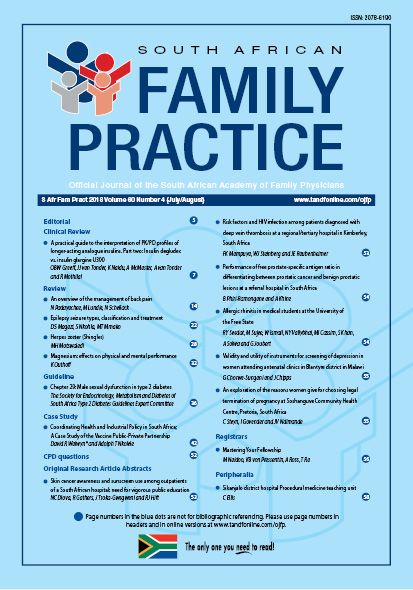Allergic rhinitis in medical students at the University of the Free State
Keywords:
allergic rhinitis, medical students, prevalence, quality of life
Abstract
Background: Allergic rhinitis, the most common form of chronic rhinitis, can adversely affect quality of life. The prevalence of allergic rhinitis in adolescents in South Africa has been estimated to be 38.5%, but there is a paucity of data from African countries on allergic rhinitis. Aim: The aim of this study was to determine the prevalence of allergic rhinitis in medical students in the Faculty of Health Science at the University of the Free State (UFS). Information was acquired on the effects that the condition had on participants with regard to symptoms, quality of life, disease management and treatment. Methods: A cross-sectional study design was used. A self-administered anonymous questionnaire was distributed to all medical students registered with the Faculty of Health Sciences at UFS in 2016. The estimated population was 706 students. Results: The response rate was 62.6%. The prevalence of allergic rhinitis was 39.1%. The most common symptoms were rhinorrhoea (64.8%), repeated sneezing (64.3%) and nasal obstruction (58.5%). Symptoms were at their worst during August to October. Antihistamines had been used by 82.4% of participants to treat their symptoms in the previous 12 months, while 28.8% had used an intranasal steroid spray. Conclusion: The prevalence of allergic rhinitis in medical students at UFS was 39.1%. Rhinorrhoea, sneezing and nasal obstruction were the most frequent and bothersome symptoms. (Full text of the research articles are available online at www.medpharm.tandfonline.com/ojfp) S Afr Fam Pract 2018; DOI: 10.1080/20786190.2018.1437869
Section
Research Articles
By submitting manuscripts to SAFP, authors of original articles are assigning copyright to the South African Academy of Family Physicians. Copyright of review articles are assigned to the Publisher, Medpharm Publications (Pty) Ltd, unless otherwise specified. Authors may use their own work after publication without written permission, provided they acknowledge the original source. Individuals and academic institutions may freely copy and distribute articles published in SAFP for educational and research purposes without obtaining permission.

